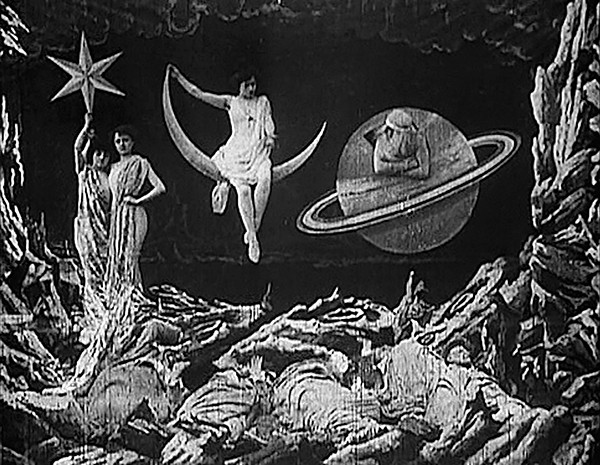I hereby declare Thursday, July 2nd, national “dance around a statue of a wizard” day. And, no, this has absolutely nothing to do with Nathan Bedford Forrest. I’m referring to the closing images of Georges Méliès’ groundbreaking 1902 silent film A Trip to the Moon, which finds a bunch of happy Earthlings celebrating science, progress, and a narrow escape from alien bug men by dancing around a wizard fountain.
A Trip to the Moon, which gets a screening at the Brooks this week, moves at a breakneck pace. It begins with a parade of science wizards with tall pointy hats and great golden telescopes that vanish on command. They’ve assembled in a magnificent hall of science, lovely assistants in tow, to hear a fellow wizard’s plan for colonizing space. There’s dissent in the ranks, but it’s quickly squelched, and in an eyeblink, wizard robes and hats are replaced by frock coats and toppers. Factory smoke belches into the sky. An enormous gun is constructed. A hollow bullet is shot right into the eye of a smirking moon. The human payload is delivered. Cinema history is made. Visually speaking, we move from the Renaissance to the Industrial Revolution to the Space Race and beyond, all in about seven minutes. And that’s just the beginning.

Méliès started out as a stage magician, and he brought the mystery, drama, and wonder of a great stage show to every frame of his most famous film. He also brought a good deal of vaudeville glamor and silliness. Loosely based on Jules Verne’s science fiction novel From the Earth to the Moon, the 12-minute epic cost 10,000 francs and took four months to complete. It was only one of the 23 movies the cinematic wizard and grandfather of fantasy film and special effects would complete that year.
Animation aliens have always played a big role in computer gaming, and A Trip to the Moon is being screened in conjunction with the Brooks’ “Art of Video Games” exhibit.